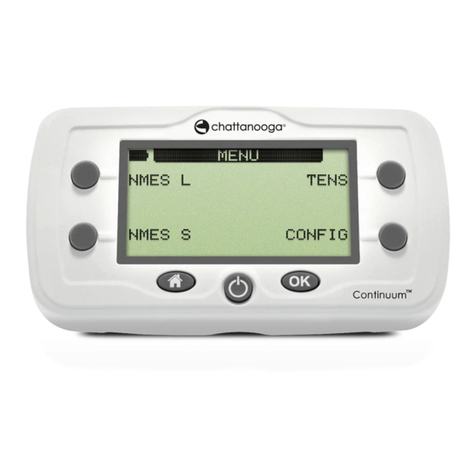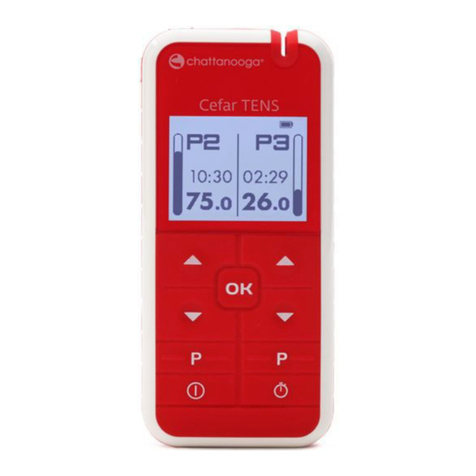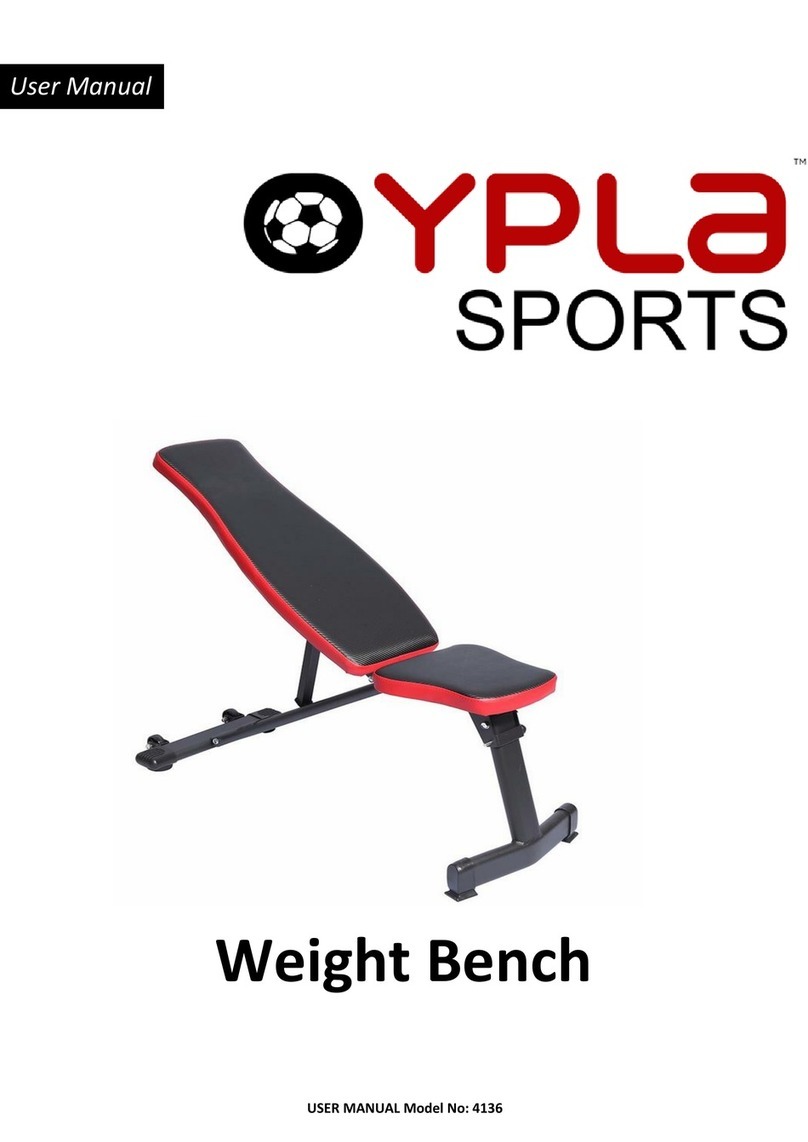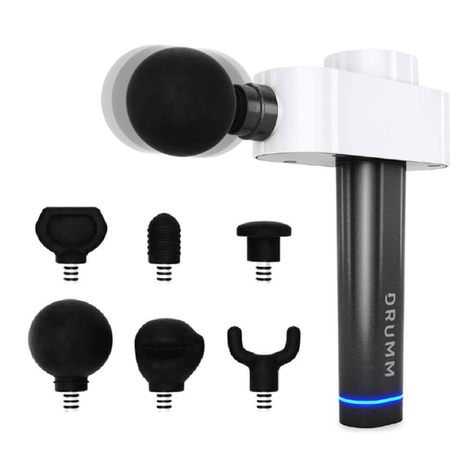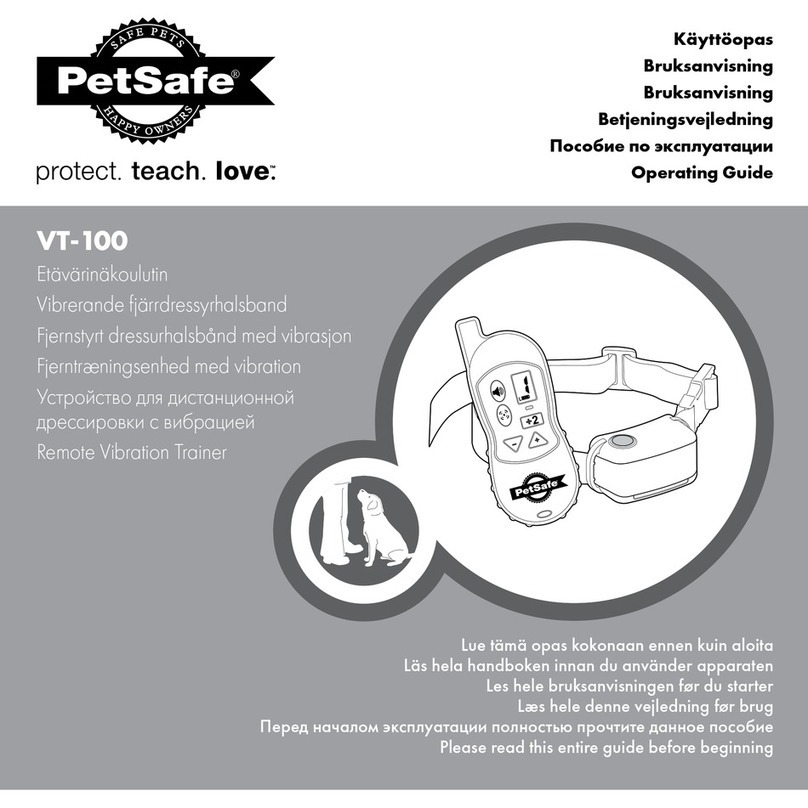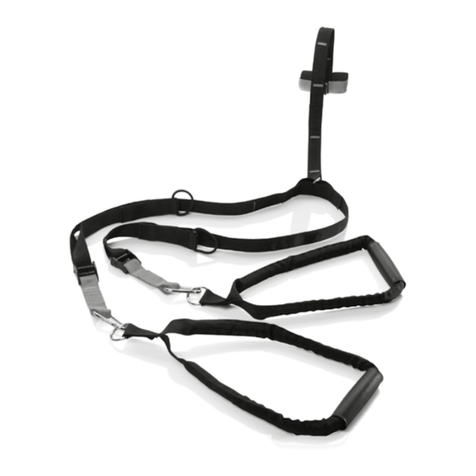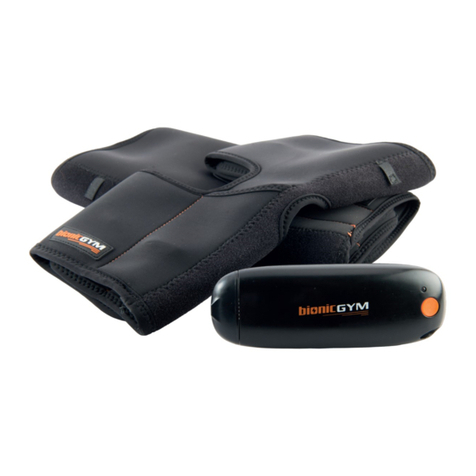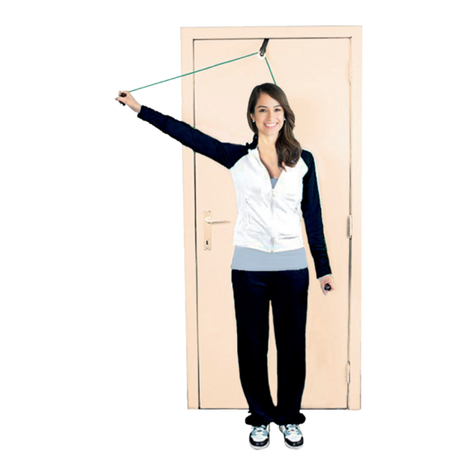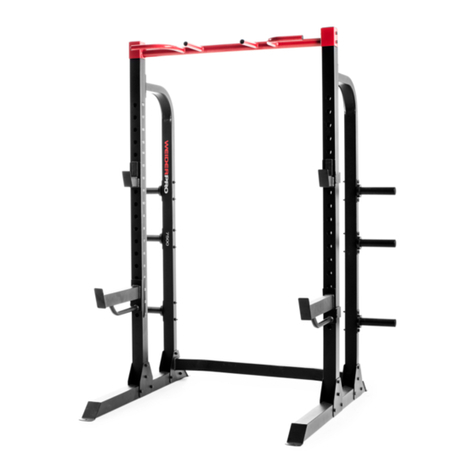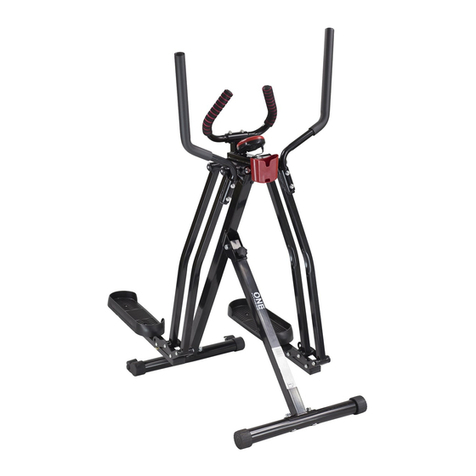Chattanooga Wireless Professional User manual

Wireless Professional
User Manual EN

QUICK START GUIDE
EN
WIRELESS PROFESSIONAL
Note
-It is strongly advised to carefully read the contraindications and safety measures described in
chapter 1 and 2 in this manual before using your device.
-For detailed information on usage also see Chapters 3 to 14 of this manual.
1. Turn the Remote Control on, by pressing the On/
Off button.
2. Upon activation the screen displays a list that
gives you access to the categories of programmes.
3. Select a program category and a program within
the category by using the navigation pad
(up/down)
4. Confirm your choice with the centre button.
5. Stick the electrodes on the patient and connect
the modules.
6. Turn on the modules, being careful to respect the
order of activation of the modules, the turning-on
order corresponds to the channel numbering.

QUICK START GUIDE
EN
WIRELESS PROFESSIONAL
7. Validate everything by pressing the button below
the START symbol.
If the mi-SCAN function is activated, a short sequence of
measures is performed. Throughout the duration of the test,
it is important to stay still and be perfectly relaxed. When the
test is complete, the programme can begin.
8. Start the stimulation by increasing the energies of
the channels.
To pause the device, press the centre button.
9. At the end of the programme press the centre
button to return to the main menu or press the
On/Off button to turn off the device.

CONTENTS
EN
WIRELESS PROFESSIONAL
1. How to Use the Medical Equipment (Intended Use)..........................................................................................7
1.1 Fields of application ..............................................................................................................................................................................7
1.2 Therapy objectives ................................................................................................................................................................................7
1.3 Indications.................................................................................................................................................................................................8
1.4 Contraindications..................................................................................................................................................................................8
1.5 Secondary eects ................................................................................................................................................................................. 9
2. Safety Information....................................................................................................................................................10
3. Description of the Wireless Professional............................................................................................................. 18
3.1 Device components and accessories..........................................................................................................................................18
3.2 Explanation of symbols (connections and nameplates) ..................................................................................................20
3.2.1 Symbols on device and AC Power Supply............................................................................................................................20
3.2.2 Symbols on Charging Tablet/Docking Station and AC Power Supply ....................................................................22
3.3 Description of the device components.................................................................................................................................... 24
3.3.1 Remote Control ............................................................................................................................................................................... 24
3.3.2 Modules............................................................................................................................................................................................... 25
3.4 Description of key accessories..................................................................................................................................................... 26
3.4.1 Smart 4CH docking station and Removeable tablet ..................................................................................................... 26
3.4.2 Basic 2 CH docking station ........................................................................................................................................................27
3.4.3 The Motor Point Pen .................................................................................................................................................................... 28
3.5 Description of key Displays shown............................................................................................................................................ 29
3.5.1 Display in Programme Category selection mode (Home Screen)............................................................................ 29
3.5.2 Display in Programme selection mode ................................................................................................................................30
3.5.3 Diplay when programm is selected, Modules need to be turned on, mode........................................................ 31
3.5.4 Display during treatment ............................................................................................................................................................32
3.5.5 Display during pause in treatment..........................................................................................................................................33
3.5.6 Display at the end of a treatment .......................................................................................................................................... 34
4. Device Setup...............................................................................................................................................................35
4.1 Smart 4CH Docking station - Connecting the unit, performance check..................................................................35
4.2 Charging the Remote Control and the Modules ............................................................................................................... 36
4.3 Multi-Sessions mode – Synchronisation with few remotes and Smart 4CH Docking station .................... 38
4.4 Basic 2CH Docking station - Connecting the unit, performance check ................................................................. 39
5. How to Perform a Treatment, Performance Check ........................................................................................40
5.1 Select a Program ............................................................................................................................................................................... 40
5.2 Adjust treatment options................................................................................................................................................................41
5.3 Electrode placement .........................................................................................................................................................................41
5.4 Body positioning of the patient ..................................................................................................................................................42
5.5 Connecting the modules to the electrodes........................................................................................................................... 43
5.6 Starting the treatment....................................................................................................................................................................44

CONTENTS
EN
WIRELESS PROFESSIONAL
5.7 Ending the treatment ......................................................................................................................................................................46
5.8 Performance Check..........................................................................................................................................................................46
6. Treatment Options, Functions and Device Settings........................................................................................47
6.1 How to use the Motor Point Pen ............................................................................................................................................... 47
6.2 Treatment Options – Muscle Intelligence™ Technology ................................................................................................49
6.2.1 Selection of the body area..........................................................................................................................................................49
6.2.2 Energy management ...................................................................................................................................................................50
6.2.3 Triggering of contraction............................................................................................................................................................. 51
6.3 Available Functions............................................................................................................................................................................53
6.3.1 The Favorite List ...............................................................................................................................................................................53
6.3.2 The Lock Out function.................................................................................................................................................................54
6.3.3 The Synchronisation Signal........................................................................................................................................................ 56
6.3.4 Identify modules..............................................................................................................................................................................57
6.4 Available device Settings................................................................................................................................................................ 58
6.5 WIRELESS PROFESSIONAL SOFTWARE
(firmware update remote control, customized programs, patient history)................................................................. 60
6.5.1 Firmware update of the Remote Control........................................................................................................................... 60
6.5.2 Additional Functions of the SOFTWARE, when having a WIRELESS PROFESSIONAL device....................61
6.5.2.1 History list ....................................................................................................................................................................................... 62
6.5.2.2 Create a patient’s list and monitor their treatment progress ................................................................................ 63
6.5.2.3 Create customized stimulation programs.......................................................................................................................64
6.5.2.4 Remote Synchronization......................................................................................................................................................... 67
6.5.2.5 Configuration/Settings.............................................................................................................................................................68
6.5.2.6 Help...................................................................................................................................................................................................69
7. Troubleshooting ....................................................................................................................................................... 70
7.1 Errors shown on display..................................................................................................................................................................70
7.2 Behaviour of the Module LEDs ....................................................................................................................................................73
7.3 Behaviour of the Docking Station LEDs ................................................................................................................................. 74
7.4 Others......................................................................................................................................................................................................75
8. Care, Maintenance, Transport, Environmental Statement............................................................................78
8.1 Care .......................................................................................................................................................................................................... 78
8.2 Maintenance........................................................................................................................................................................................ 79
8.3 Transport .............................................................................................................................................................................................. 80
8.3.1 Transport of the 4CH device key components and the Tablet (o site treatment)........................................ 80
8.3.2 Shipping the entire 4CH unit (incl. Smart Docking Station)........................................................................................81
8.3.3 Transport of the 2CH device key components.................................................................................................................. 82
8.3.4 Shipping the entire 2CH unit (incl. Basic Docking Station)......................................................................................... 83
8.4 Enviromental Statement, Expected Life..................................................................................................................................84

CONTENTS
EN
WIRELESS PROFESSIONAL
9. Technical Data, Standards, Guarantee, Patents............................................................................................... 85
9.1 Technical Data ..................................................................................................................................................................................... 85
9.1.1 General information ....................................................................................................................................................................... 85
9.1.2 Neuro-Stimulation Parameters................................................................................................................................................86
9.1.3 RF data.................................................................................................................................................................................................86
9.1.4 Information on electromagnetic compatibility (EMC) ................................................................................................. 87
9.1.5 Enviromental conditions.............................................................................................................................................................. 87
9.2 Standards ..............................................................................................................................................................................................88
9.3 Guarantee .............................................................................................................................................................................................88
9.4 Patents...................................................................................................................................................................................................88
10. EMC Tables............................................................................................................................................................... 89
10.1 Electromagnetic emissions..........................................................................................................................................................89
10.2 Electromagnetic immunity ....................................................................................................................................................... 90
10.3 Recommended separation distances .................................................................................................................................... 92
11. Contact........................................................................................................................................................................93
12.Electrotherapy Theory............................................................................................................................................ 94
12.1 Introduction.........................................................................................................................................................................................94
12.1.1 The fundamental law of electrostimulation.......................................................................................................................94
12.1.2 Summary ...........................................................................................................................................................................................98
12.1.3 References.........................................................................................................................................................................................99
12.2 The Optimum Current...................................................................................................................................................................99
12.2.1 Introduction......................................................................................................................................................................................99
12.2.2 Characteristics of the optimal current................................................................................................................................99
12.2.2.1 Electrical stimulation wave produced by the current generator..........................................................................99
12.2.2.2 Type of establishment of the electrical stimulation wave................................................................................... 100
12.2.2.3 Shape of the electrical stimulation wave.......................................................................................................................101
12.2.2.4 Duration of rectangular electrical pulse ....................................................................................................................... 102
12.2.2.5 Compensation for the rectangular pulse......................................................................................................................104
12.2.3 Summary......................................................................................................................................................................................... 105
12.3 Basic concepts of excitation electrophysiology................................................................................................................ 105
12.3.1 Introduction.................................................................................................................................................................................... 105
12.3.2 Study of the excitation process using a constant current........................................................................................ 107
12.3.3 Excitation by a current with any shape ............................................................................................................................109
12.3.4 Chronaxy - excitation constant relationship .................................................................................................................109
12.3.5 Hydraulic model of excitation ................................................................................................................................................110
13. Available Therapy Programs ................................................................................................................................ 112
13.1 Standard Version Programs and their usage........................................................................................................................112
13.1.1 Program category REHABILITATION I..................................................................................................................................113
13.1.2 Program category PAIN RELIEF.............................................................................................................................................122

CONTENTS
EN
WIRELESS PROFESSIONAL
13.1.3 Program category VASCULAR.................................................................................................................................................131
13.1.4 CONDITIONING I.........................................................................................................................................................................139
13.2 Full Version Programs and their usage (Indication Specific Programs)................................................................ 144
13.2.1 REHABILITATION II..................................................................................................................................................................... 146
13.2.2 AGONIST / ANTAGONIST .......................................................................................................................................................160
13.2.3 PROGRAMMES FOR HAEMOPHILIACS............................................................................................................................163
13.2.4 NEUROLOGICAL......................................................................................................................................................................... 166
13.2.5 PAIN RELIEF II................................................................................................................................................................................174
13.2.6 CONDITIONING II......................................................................................................................................................................190
14. How to Use the Wireless Professional on Specific Indications.................................................................209
14.1 Overview ........................................................................................................................................................................................... 209
14.2 Disuse atrophy rehabilitation (standard protocol) ...........................................................................................................211
14.3 Rehabilitation of the peroneus muscles following an ankle sprain.........................................................................213
14.4 Rehabilitation of low back muscles .......................................................................................................................................216
14.5 Treatment of patellofemoral syndrome ...............................................................................................................................219
14.5.1 Lateral tracking..............................................................................................................................................................................219
14.5.2 Post-traumatic condition ....................................................................................................................................................... 222
14.6 ACL ligamentoplasty....................................................................................................................................................................224
14.7 Rehabilitation of the gluteal muscles following total hip replacement................................................................228
14.8 Rehabilitation of the shoulder.................................................................................................................................................230
14.8.1 Rotator cu tendinopathy.......................................................................................................................................................231
14.8.2 Shoulder instabilities................................................................................................................................................................. 235
14.8.3 Adhesive capsulitis.....................................................................................................................................................................238
14.8.4 Cardiac Rehabilitation ..............................................................................................................................................................241
14.9 Reflex sympathetic dystrophy (or Complex regional pain syndrome) .................................................................244
14.10 Endorphinic treatment of Rachialgia and Radiculalgia..............................................................................................249
14.10.1 Endorphinic treatment of cervical pain............................................................................................................................251
14.10.2 Endorphinic treatment of thoracic back pain ............................................................................................................. 253
14.10.3 Endorphinic treatment of low back pain....................................................................................................................... 255
14.10.4 Treatment of lumbosciatic pain ........................................................................................................................................258
14.11 Hemiplegia - Spasticity ...............................................................................................................................................................261
14.11.1 Dorsiflexion of the hemiplegic foot....................................................................................................................................262
14.11.2 Spasticity........................................................................................................................................................................................264
14.11.3 The hemiplegic hand................................................................................................................................................................268
14.11.4 The hemiplegic shoulder....................................................................................................................................................... 270
14.12 Treatment of venous insuciency ....................................................................................................................................... 273
14.12.1 Venous insuciency without oedema ............................................................................................................................ 273
14.12.2 Venous insuciency with oedema................................................................................................................................... 275
14.13 Treatment of arterial insuciency in the lower limbs ................................................................................................278
14.13.1 Stage II arterial insuciency.................................................................................................................................................279
14.13.2 Stage III arterial insuciency................................................................................................................................................281

. HOW TO USE THE MEDICAL EQUIPMENT INTENDED USE
EN
WIRELESS PROFESSIONAL
Note
- This manual is considered as an accessory of the therapy unit and therefore it should accompany it
at all times.
- The specific instructions provided given here are conditions for the intended use and correct
operation of the equipment as well as the safety of the patient and the operator using it.
- Please read the entire manual carefully and section 2 in particular, since information concerning
several chapters is only given once, before using your device!
1.1 Fields of application
The Wireless Professional is a stimulator designed for use by health professionals to ensure electric
stimulation treatments in pain management (TENS) as well as for neuro muscular stimulation (EMS/
NMES).
The Wireless Professional physiotherapy unit is an important supplement to medical and therapeutic
treatment for use in hospitals, clinics, general practices and at a patient’s home by a therapist.
1.2 Therapy objectives
The Wireless Professional is a multifunctional electrotherapy unit for the post surgical and conservative
treatment of muscular imbalance as well as pain management.
The following therapy forms are provided by the unit:
• TENS (trasncutaneous nerve stimulation) for painmanagement
• NMES (neuromuscular electrical stimulation, also EMS)
• FES (functional electrical stimulation)

. HOW TO USE THE MEDICAL EQUIPMENT INTENDED USE
EN
WIRELESS PROFESSIONAL
1.3 Indications
The physiotherapy unit is indicated in the treatment of most musculoskeletal injuries and diseases as well
as in postoperative treatment after joint surgeries and in the treatment of several pain indications.
Examples:
As an NMES device, indications are for the following conditions:
- Retarding or preventing disuse atrophy
- Maintaining or increasing range of motion
- Re-educating muscles
- Relaxation of muscle spasms
- Increasing local blood circulation
As a TENS device, indications are for the following conditions:
- Symptomatic relief and management of chronic, intractable pain
- Adjunctive treatment for post-surgical and post-trauma acute pain
- Relief of pain associated with arthritis.
1.4 Contraindications
Do NOT use the Wireless Professional on patients with:
• Implanted electronic devices. Do not use the device if you have a cardiac stimulator, implanted
defibrillator or other implanted electronic/electrical device. Epilepsy
• Pregnancy (do not use on abdominal region)
• Serious arterial circulation problems in lower limbs
• Abdominal or inguinal hernia
• Do not use chest stimulation on patients with cardiac arrhythmia
• This could cause an electrical shock, burns, electrical interference or death
Heart disease
If you have suspected or diagnosed cardiopathy you should follow the precautions for use recommended
by your doctor.

. HOW TO USE THE MEDICAL EQUIPMENT INTENDED USE
EN
WIRELESS PROFESSIONAL
Note
Metalwork and/or prosthesis equipment
The presence of metalwork and/or prosthesis equipment (metallic equipment in contact with the
bone: pins, screws, plates, prostheses, etc.) is not a contraindication. The electrical currents of the
Wireless Professional are specially designed to have no harmful eect on osteosynthesis equipment.
1.5 Secondary effects
Currently, there is no evidence of desired or undesired secondary eects caused by electrotherapy units.

. SAFETY INFORMATION
EN
WIRELESS PROFESSIONAL
Definitions
It is mandatory to read the safety statements before using the physiotherapy unit. The safety statements
are classified as follows:
Safety information
Danger!
This term indicates an imminent hazard. If not avoided, this hazard could result in death or
serious injury.
Danger!
Explosion hazard - Wireless Professional is not designed for use in areas where an
explosion hazard may occur. An explosion hazard may result from the use of flammable
anesthetics, oxygen-rich environments, skin cleansing agents and disinfectants.
Caution!
This term indicates a potential hazard. If not avoided, this hazard can result in minor
personal injury and/or product/property damage.
Warning!
This term indicates a hazard. If not avoided, this hazard can result in death or serious injury.

. SAFETY INFORMATION
EN
WIRELESS PROFESSIONAL
Warning!
Patient hazard -
- Only authorized individuals are allowed to operate the Wireless Professional. Individuals
are authorized after receiving training in the operation of the unit and reading this
operating on manual.
- Before using the therapy unit, the operator must ascertain that it is in correct working
order and operating condition. The cables and connectors, in particular, must be checked
for signs of damage. Damaged parts must be replaced immediately, before use.
- Stop therapy immediately if you have doubts about the device settings and/or the
therapy protocol.
- Patients must be fully conscious while being instructed in the use of the therapy unit and
during therapy.
- The choice of the therapy parameters to program and of the therapy protocols to use
is restricted to the responsible physician or therapist. It is the physician’s or therapist’s
decision whether or not to use the unit on a specific patient.
- The patient must be familiar with the functions of the Wireless Professional remote
control with the modules and the remote control must be within easy reach of the
patient, allowing them to stop therapy, if needed. Patients unable to operate the
emergency stop function (either by stopping on the remote control or by turing of the
modules), e.g. paralytic patients, must never be left unattended during therapy.
- Any accessories used with Wireless Professional must first be approved by the
manufacturer.
- The utmost caution is advised under the following conditions. Depending on the
judgement of the responsible physician, the unit may only be applied under supervision
and with the parameters defined by the responsible physician. Otherwise the exercise
may be too strenuous for the patients with :
1. hypertension (> stage 2), ischemic heart disease and cerebrovascular diseases
2. cardiovascular diseases
3. pregnancy
4. under 16 years of age
- Never apply the electrodes:
• Near the head
• On the front and side of the neck
• Counter-laterally, i.e. do not use two poles connected to the same channel on opposite
sides of the body.
• On or near skin lesions of any kind (wounds, swelling, burns, irritation,
eczema, cancerous lesion, etc.)
- If the person is pregnant or menstruating do not place electrodes directly on the uterus
area or connect pairs of electrodes on either side of the abdomen to avoid any risk for
the mother and/or the baby.

. SAFETY INFORMATION
EN
WIRELESS PROFESSIONAL
- Never allow muscular contraction during a stimulation session to result in movement.
You should always stimulate isometrically; this means that the extremities of the limb in
which a muscle is being stimulated must be firmly fixed, so as to prevent any movement
that results from contraction.
Warning!
- Extreme caution should be taken when in use around small children and babies!
Sucient distance to the device and its accessories is mandatory for their safety!
- Never leave the device unattended when it is switched on! Switch the device o and
disconnect the electrodes from the modules!
- After use, store the device in a safe place to avoid other people not informed to use the
device!
- This device is not a toy but a medical device where misunderstanding or misuse can
cause damage!
Warning!
Shock hazard - Strictly observe the following warnings. Failure to do so could endanger the
lives of the patient, the user and other persons involved.
- Before use allow the Wireless Professional to reach room temperature. If the unit has been
transported at temperatures below 0 °C (32°F), leave it to reach at room temperature for about 2
hours, until any condensation has disappeared.
- Electrosurgical equipment or defibrillators. Disconnect the electrodes from the device before
using electrosurgical equipment, or a defibrillator, to avoid cutaneous burns from the electrodes
and destroying the device.
- Electronic surveillance equipment. Do not apply stimulation near electronic surveillance
equipment (e.g. cardiac monitors, ECG alarms), as there is a risk they may not work properly whilst
the electrical stimulation device is being used.
- Electromagnetic radiation. Do not use the stimulator in areas in which unprotected devices are
used to emit electromagnetic radiation. Portable communications equipment can interfere with
the device.
- Cancer. Do not apply stimulation if you have progressive cancer or near any cancerous tumour.
The increased metabolism, caused by certain modes of stimulation, is likely to encourage cancer
cells to spread

. SAFETY INFORMATION
EN
WIRELESS PROFESSIONAL
- Do not use the Wireless Professional in water or in a humid atmosphere (sauna, Bath, Shower
etc.) that would cause electronic failure.
- Water protection. The unit is not protected from the ingress of water
- When connecting the unit to other equipment or when creating a medical system, check that
the sum of leakage currents will not cause any hazard. Please contact DJO GLOBAL if you have
questions regarding this matter.
- No modification of this equipment is allowed.
- Do not open the product and its accessories as there is risk of electrocution
- Muscle shortening. During the muscular contraction phase it is recommended to hold the
extremities of the stimulated limbs to avoid any shortening of the muscle during contraction,
which could cause cramps.
- Contralateral stimulation. Do not use two terminals connected to the same channel on opposite
segments of the body (for example, a positive terminal on the left arm and a negative terminal on
the right arm).
- Loss of sensation. Proceed with caution if stimulation is applied to areas of the skin where the
level of sensation is lower than normal. Do not apply stimulation to a person who cannot express
themselves.
- Battery leakage. If there is leak from a component, take steps to ensure the liquid does not come
into contact with skin or eyes. Should this occur, wash the aected area with water and consult a
doctor.
- Strangulation. Do not wind cables around the neck. Tangled cables can cause strangulation.
- Post-surgery. Proceed with caution after recent surgery.
- Accessibility of the power adaptor. The plug socket must be close to the power adaptor and be
easily accessible.
- Internal bleeding. Proceed with caution if you are prone to internal bleeding; for example, after an
injury or a fracture.
The Wireless Professional must only be operated in dry rooms.
- Before cleaning and service interventions, turn the remote control and the modules o and
disconnect the tablet from the power line by removing the power cord from the wall outlet.
- Liquids and foreign material (such as dust, metal etc.) must not be allowed to enter the remote
control, the modules, the charging tablet or the power supply. If such material has entered into the
units, it must be immediately checked by a service technician, before it can be reused.
- Electricity supply. Never connect the stimulation cables to an external power supply, as there is a
risk of electrocution

. SAFETY INFORMATION
EN
WIRELESS PROFESSIONAL
Warning!
Equipment malfunction - these warnings can cause equipment malfunctions that result in
patient hazards
- Magnetic and electrical fields are capable of interfering with the proper performance of
the unit. For this reason make sure that all external devices operated in the vicinity of the
unit comply with the relevant EMC requirements. X-ray equipment, MRI devices, radio
systems and cell phones are possible sources of interference as they may emit higher
levels of electromagnetic radiation.
Keep the unit away from such equipment and verify its performance before use.
- Do not use the Wireless Professional within one metre of short wave or microwave
devices as this could alter the currents generated by the stimulator. If you are in any
doubt as to the use of the stimulator in close proximity to another medical device, seek
advice from the manufacturer of the latter or from your doctor.
- Exercise caution when using electrotherapy while the patient is connected to monitoring
equipment with electrodes attached to the body. Stimulation could disrupt the signals
sent to the monitoring equipment.
- Refer repair and maintenance to autorised persons. Persons are authorized after
training by a specialist trained and commissioned by the manufacturer.
- Inspect the Wireless Professional and it’s accessories for damage and loose connections
at least once a year. Damaged and worn parts must be immediately replaced with
original spare parts by autorised sta.
- Do not apply stimulation near the area of an implant, such as cochlear implants, pacemakers,
skeletal anchorage or electric implants. This could cause an electrical shock, burns, electrical
interference or death
- Never use the Wireless Professional or the AC adaptor if it is damaged or open. There is a risk of
electric shock.
- Disconnect the AC adaptor immediately if there is abnormal heating or smell, or if smoke comes
from the AC adaptor or the device.
- Do not place the docking station in a confined space (carrying case, drawer etc.) when charging
the device. There is a risk of electrocution.

. SAFETY INFORMATION
EN
WIRELESS PROFESSIONAL
Caution!
Patient hazard - these cautions need to be observed to avoid the risk of electrical shock or
other negative eects to the patient.
- Do not apply stimulation close to metal. Remove jewellery, piercings, belt buckles or any
other metallic product or device in the area of stimulation.
- Be careful if the patient has sensitivity problems or is not able to communicate that he or
she feels discomfort, however light.
- Never begin an initial stimulation session on a person who is standing. The first five
minutes of stimulation must always be performed on a person who is sitting or lying
down. In rare instances, people of a nervous disposition may experience a vasovagal
reaction. This is of psychological origin and is connected with a fear of the muscle
stimulation as well as surprise at seeing one of their muscles contract without having
intentionally contracted it themselves. A vasovagal reaction causes heart to slow down
and blood pressure to drop, which produces a feeling weakness and a tendency towards
fainting. If this does occur, all that is required is to stop the stimulation and for the person
to lie down with the legs raised until the feeling of weakness disappears (5 to 10 minutes)
- Never allow muscular contraction during a stimulation session to result in movement.
You should always stimulate isometrically; this means that the extremities of the limb in
which a muscle is being stimulated must be firmly fixed, so as to prevent any movement
that results from contraction.
- Do not disconnect any module that is switched on during the stimulation session. They
must be switched o first.
- Do not use the stimulator while driving or operating machinery.
- Do not apply stimulation during sleep.
- Do not use the stimulator at altitudes of over 3,000 meters.
- Always turn o the stimulator before moving or removing any electrodes during a
session, to avoid electrical shock to the patient.
- Do not try to place electrodes on a body part not directly visible without assistance.
- Attach the electrodes in such a way that their entire surface is in contact with the skin.
- For obvious reasons of hygiene, each patient must have their own set of electrodes. Do
not use the same electrodes on dierent patients.
- Some patients with very sensitive skin may experience redness under the electrodes after
a session. Generally, this redness is completely harmless and usually disappears after 10
to 20 minutes. Never start another stimulation session in the same area, however, if the
redness is still visible.
- Before each use clean and disinfect the motor point pen tip that is in contact with the
skin.
- When using the WIRELESS PROFESSIONAL SOFTWARE to customize programs, take
special care that the parameters customised and applied by you to the patient are as you
wanted them to be (program architecture shown on screen before treatment starts).

. SAFETY INFORMATION
EN
WIRELESS PROFESSIONAL
Caution!
Equipment damage -
- Do not let the modules get in contact with massage oils or any other products of the
same type that could damaged the device or its accessories.
- Check that the voltage and frequency ratings of your local power line are those indicated
on the type plate of the power supply.
- Do not expose the Wireless Professional to direct sunlight, because some of the
components may reach unacceptably high temperatures.
- The presence of children, and pets does not normally aect the proper functioning.
However, Keep pets and children away from the product. Also, keep the unit clean and
protect it from dust and lint. The safety rules and regulations set forth apply in any case.
- It is recommended to use the transport bag that comes with the unit, for transport of the
device, and to use a proper transport box to ship it.
- Always use the AC adaptor (power supply) provided by the manufacturer to recharge the
unit.
- Do not store the modules and remote control for a long time with empty batteries.
- Only use electrodes and motor point pen supplied by the manufacturer. Other electrodes
and motor point pens may have electrical properties that are unsuitable for or may
damage the Wireless Professional.
- Size of electrodes. Do not use electrodes with an active area of less than 16 cm² due to
the risk of associated burning. Proceed systematically with caution when the density of
the current is over 2 mA/cm².
- Do not place the electrodes or pen in water.
- Do not apply solvents of any kind to the electrodes or pen.
- Skin irritation. Some people, with very sensitive skin, may experience redness under
the electrodes after a session. Generally, this redness is totally harmless and usually
disappears after 10 to 20 minutes. However, never start another stimulation session on
the same area if the redness is still visible
- Instructions for electrodes. See the usage and storage instructions displayed on the bag
of electrodes

. SAFETY INFORMATION
EN
WIRELESS PROFESSIONAL
Note
- For best results, wash and clean the skin of any oil and dry it before attaching the electrodes.
- Never use a set of adhesive electrodes for more than 15 sessions as the quality of the contact
between the electrode and the skin, which is essential for the patient’s comfort and the
eectiveness of the stimulation, gradually deteriorates.
- For information on use and storage please consult the instructions found on the electrodes
packaging.
Note
Biocompatibility
Those parts of the Wireless Professional unit that come into contact with the patient when used as
intended, are designed to fulfil the biocompatibility requirements of the applicable standards.

. DESCRIPTION OF THE WIRELESS PROFESSIONAL
EN
WIRELESS PROFESSIONAL
3.1 Device components and accessories
Model: Wireless Professional 4CH
Part number: 2532xxx
Your kit contains (included in delivery):
QUANTITY DESCRIPTION PART NUMBER
2 remote control 00113x
4 stimulation modules 984350
1 smart 4 CH docking station 6831xx
1 AC adaptor 6490xx
1 USB cable 601163
2Bags of small electrodes
(5x5 cm 1 snap connection) 42204
22 bags of large electrodes
(5x10 cm 1 snap connection) 42223
22 bags of large electrodes
(5x10 cm 2 snap connections) 42203
1 user manual and practical guide on on CD/USB 46262xx
1 quick start guide/warning leaflet 885932
1 bottle of gel 602047
1 motor point pen 980020
1 carrying case 680041
2 lanyards 1494
1 white protection sleeve 5529024
1 blue protection sleeve 5528535
1 Set of colored module clips 5529220

. DESCRIPTION OF THE WIRELESS PROFESSIONAL
EN
WIRELESS PROFESSIONAL
Model: Wireless Professional 2CH
Part number: 25326xx
Your kit contains (included in delivery):
QUANTITY DESCRIPTION PART NUMBER
1 remote control 00113x
2 stimulation modules 984350
1 Basic 2 CH docking station 101091
1 AC adaptor 108x
1 USB cable 601163
1Bag of small electrodes (5x5 cm 1 snap connection) 42204
11 bag of large electrodes (5x10 cm 1 snap
connection) 42223
11 bag of large electrodes (5x10 cm 2 snap
connections) 42203
1 user manual and practical guide on on CD/USB 46262xx
1 quick start guide/warning leaflet 885932
1 bottle of gel 602047
1 motor point pen 980020
1 transportation pouch 680085
1 lanyard 1494
1 white protection sleeve 5529024
1 Set of colored module clips 5529220
Table of contents
Other Chattanooga Fitness Equipment manuals
